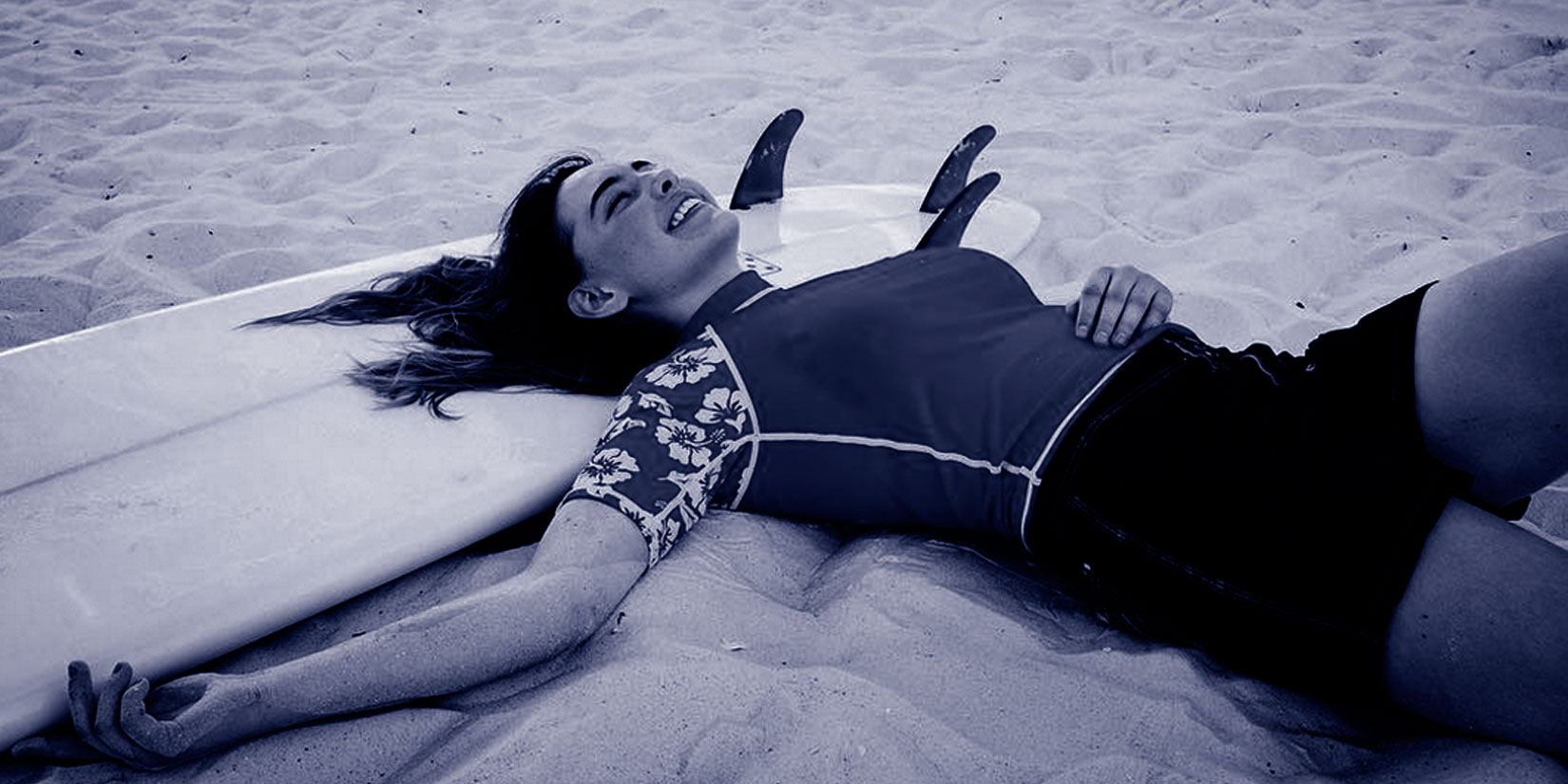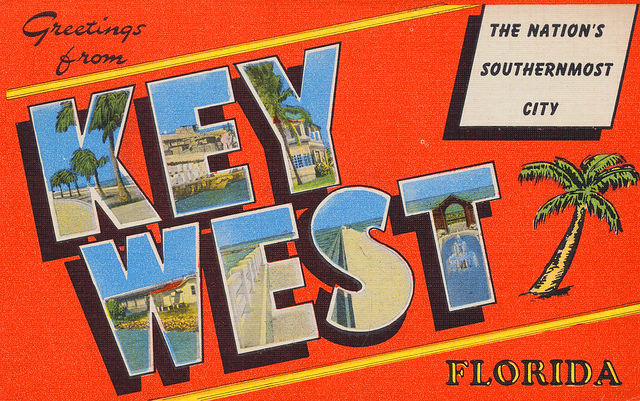Several U.S. presidents have visited Key West. Harry Truman visited for 175 days on 11 visits during his presidency and visited several times after he left office. Key West was in a down cycle when Franklin D. Roosevelt visited in 1939. The buildup of military bases on the island occurred shortly thereafter. In addition to Truman, Dwight D. Eisenhower stayed in Key West following a heart attack. In November 1962, John F. Kennedy visited Key West a month after the resolution of the Cuban Missile Crisis. Jimmy Carter held a family reunion in Key West after leaving office.
The Ernest Hemingway House, a popular tourist attraction in Key West. Legend has it that Ernest Hemingway wrote A Farewell to Arms while living above the showroom of a Key West Ford dealership at 314 Simonton Street while awaiting delivery of a Ford roadster purchased by the uncle of his wife, Pauline, in 1928. Hardware store owner Charles Thompson introduced him to deep-sea fishing. Among the group who went fishing was Joe Russell (also known as Sloppy Joe). Russell was reportedly the model for Freddy in “To Have and Have Not”. Portions of the original manuscript were found at Sloppy Joe’s Bar after his death. The group had nicknames for each other, and Hemingway wound up with “Papa”. The Hemingway’s had taken up residence at 1301 Whitehead Street until Pauline’s rich uncle Gus Pfeiffer bought the 907 Whitehead Street house in 1931 as a wedding present. Legend says the Hemingway’s installed a swimming pool for $20,000 in the late 1930s (equivalent to $330,000 in 2013). It was such a high price that Hemingway is said to have put a penny in the concrete, saying, “Here, take the last penny I’ve got!” The penny is still there. During his stay he wrote or worked on “Death in the Afternoon”, “For Whom the Bell Tolls”, “The Snows of Kilimanjaro” and “The Short Happy Life of Francis Macomber”. He used Depression-era Key West as the setting for “To Have and Have Not” — his only novel set in the United States. Pauline and Hemingway divorced in 1939, and Hemingway only occasionally visited while returning from Havana until his suicide in 1961. The six- or seven-toed cats descended from Hemingway’s original pet ‘Snowball’ still live on the grounds and are cared for at the Hemingway House, despite complaints by the U.S. Department of Agriculture that they are not kept free from visitor contact. And the Key West City Commission exempted the house from a law prohibiting more than four domestic animals per household.
Tennessee Williams first became a regular visitor to Key West in 1941 and is said to have written the first draft of “A Streetcar Named Desire” while staying in 1947 at the La Concha Hotel. He bought a permanent house in 1949 and listed Key West as his primary residence until his death in 1983. In contrast to Hemingway’s grand house in Old Town, the Williams home at 1431 Duncan Street in the “unfashionable” New Town neighborhood is a very modest bungalow. The house is privately owned and not open to the public. The Academy Award–winning film version of his play The Rose Tattoo was shot on the island in 1956. The Tennessee Williams Theatre is located on the campus of Florida Keys Community College on Stock Island. Williams had a series of rented homes all over the U.S., but the only home he owned was in Key West. Even though Hemingway and Williams were in Key West at the same time, they reportedly met only once—at Hemingway’s Cuba home Finca Vigía.
Key West is much closer to Havana than it is to Miami. In 1890, Key West had a population of nearly 18,800 and was the biggest and richest city in Florida. Half the residents were said to be of Cuban origin, and Key West regularly had Cuban mayors, including the son of Carlos Manuel de Céspedes, father of the Cuban Republic, who was elected mayor in 1876. Cubans were actively involved in reportedly 200 factories in town, producing 100 million cigars annually. José Martí made several visits to seek recruits for Cuban independence starting in 1891 and founded the Cuban Revolutionary Party during his visits to Key West. The Battleship USS Maine sailed from Key West on its fateful visit to Havana, where it blew up, igniting the Spanish-American War. Crewmen from the ship are buried in Key West, and the Navy investigation into the blast occurred at the Key West Customs House.
Pan American Airlines was founded in Key West, originally to fly visitors to Havana, in 1926. The airline contracted with the United States Postal Service in 1927 to deliver mail to and from Cuba and the United States. The mail route was known as the “Key West, Florida Havana Mail Route”. John F. Kennedy was to use “90 miles from Cuba” extensively in his speeches against Fidel Castro. Kennedy himself visited Key West a month after the resolution of the Cuban Missile Crisis. Prior to the Cuban revolution of 1959, there were regular ferry and airplane services between Key West and Havana. Key West was flooded with refugees during the Mariel Boat-lift. Refugees continue to come ashore and, on at least one occasion, most notably in April 2003, flew hijacked Cuban Airlines planes into the city’s airport.
In 1978, the mayor of Key West, Charles “Sonny” McCoy, water-skied to Cuba. Although local legend and authors such as Joy Williams have claimed McCoy did this to demonstrate the necessity of a military presence in Key West , sources from the time make no note of such a motivation for the stunt. He made the trip in 6 hours, 10 minutes on a slalom ski. In 1982 the city of Key West briefly declared its “independence” as the Conch Republic in a protest over a United States Border Patrol blockade. This blockade was set up on U.S. 1, where the northern end of the Overseas Highway meets the mainland at Florida City. The blockade was in response to the Mariel Boatlift. A traffic jam of 17 miles ensued while the Border Patrol stopped every car leaving the Keys, supposedly searching for illegal immigrants attempting to enter the mainland United States. This paralyzed the Florida Keys, which rely heavily on the tourism industry. Flags, T-shirts and other merchandise representing the Conch Republic are still popular souvenirs for visitors to Key West, and the Conch Republic Independence Celebration—including parades and parties—is celebrated every April 23.
Like most tropical climates, Key West has two seasons – the wet season and the dry season. The dry season runs from November through April and is normally sunny and quite dry, with only 25 percent of the annual rainfall occurring. This rainfall usually occurs in advance of cold fronts in a few light showers. In some years the winter can see severe drought conditions. May through October is normally the wet season. During the wet season some rain falls on most days, often in quick tropical downpours, followed by intense sun. Early morning is the favored time for these showers, which is different from mainland Florida, where showers and thunderstorms usually occur in the afternoon. Easterly (tropical) waves during this season occasionally bring excessive rainfall, while infrequent hurricanes may be accompanied by unusually heavy amounts. At any rate, Key West is the driest city in Florida.
The original Key West settlement on the western part of the island is called “Old Town” and comprises the Key West Historic District. It includes the major tourist destinations of the island, including Mallory Square, Duval Street, the Truman Annex and Fort Zachary Taylor. It is where are found the classic bungalows and guest mansions.
Generally, the structures date from 1886 to 1912. The basic features that distinguish the local architecture include wood-frame construction of one- to two-and-a-half-story structures set on foundation piers about three feet above the ground. Exterior characteristics of the buildings are peaked “metal” roofs, horizontal wood siding, gingerbread trim, pastel shades of paint, side-hinged louvered shutters, covered porches (or balconies, galleries, or verandas) along the fronts of the structures, and wood lattice screens covering the area elevated by the piers.
One of the biggest attractions on the island is a concrete replica of a buoy at the corner of South and Whitehead Streets that claims to be the southernmost point in the contiguous 48 states . The point was originally just marked with a sign, which was often stolen. In response to this, the city of Key West erected the now famous monument in 1983. Brightly painted and labeled “SOUTHERNMOST POINT CONTINENTAL U.S.A.”, it is one of the most visited and photographed attractions in Key West. However, the marker is not located at the southernmost point in the continental United States. Whitehead Spit, on the Truman Annex property just west of the buoy, is the true southernmost point, but it has no marker since it is U.S. Navy land and cannot be entered by civilian tourists.



